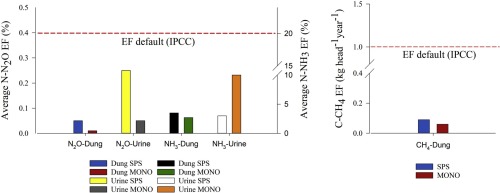当前位置:
X-MOL 学术
›
Agric. Ecosyst. Environ.
›
论文详情
Our official English website, www.x-mol.net, welcomes your feedback! (Note: you will need to create a separate account there.)
Nitrous oxide, methane, and ammonia emissions from cattle excreta on Brachiaria decumbens growing in monoculture or silvopasture with Acacia mangium and Eucalyptus grandis
Agriculture, Ecosystems & Environment ( IF 6.6 ) Pub Date : 2020-06-01 , DOI: 10.1016/j.agee.2020.106896 Igor L. Bretas , Domingos S.C. Paciullo , Bruno J.R. Alves , Márcio R. Martins , Abmael S. Cardoso , Marina A. Lima , Renato A.R. Rodrigues , Fabyano F. Silva , Fernanda H.M. Chizzotti
Agriculture, Ecosystems & Environment ( IF 6.6 ) Pub Date : 2020-06-01 , DOI: 10.1016/j.agee.2020.106896 Igor L. Bretas , Domingos S.C. Paciullo , Bruno J.R. Alves , Márcio R. Martins , Abmael S. Cardoso , Marina A. Lima , Renato A.R. Rodrigues , Fabyano F. Silva , Fernanda H.M. Chizzotti

|
Abstract We quantified nitrous oxide (N2O), methane (CH4), and ammonia (NH3) emissions from cattle urine and dung patches on Brachiaria decumbens growing in a long-term silvopasture (SPS) or in monoculture (MONO) during the annual rainy and dry periods in southwest Brazil. We hypothesized that microenvironmental changes triggered by dense shade and litter, provided by trees, and pasture quality in SPS would affect greenhouse gas emissions from cattle excreta. Two field trials (rainy and dry season) were carried out using manual closed static chambers in a 3 × 2 factorial scheme, corresponding to three excreta types (urine, dung, and control without excreta) and two pasture systems (SPS and MONO), in a block design with three blocks and two replicates per block (n = 6 per treatment). Generally, N2O and CH4 fluxes were higher in SPS than in MONO. Notably, N losses in the form of N2O did not exceed 0.10 %, except for N2O emissions from urine deposited during the rainy season in SPS (0.39 % of applied N). Cattle dung was also a source of CH4. The highest fluxes were observed under SPS during the rainy season, but emissions were generally low, with emission rates
中文翻译:

单作或林场与金合欢和巨桉一起生长的卧伏臂上的牛排泄物中的一氧化二氮、甲烷和氨排放
摘要 我们量化了在长期林场 (SPS) 或单一栽培 (MONO) 中生长的牛尿和粪便中的一氧化二氮 (N2O)、甲烷 (CH4) 和氨 (NH3) 排放量巴西西南部干旱期。我们假设由树木提供的浓密遮荫和凋落物以及 SPS 中的牧场质量引发的微环境变化会影响牛排泄物的温室气体排放。使用手动封闭静态室以 3 × 2 因子方案进行了两次田间试验(雨季和旱季),对应于三种排泄物类型(尿液、粪便和无排泄物的对照)和两种牧场系统(SPS 和 MONO),在具有三个区组和每个区组两个重复的区组设计中(每个处理 n = 6)。一般来说,SPS 中的 N2O 和 CH4 通量高于 MONO。值得注意的是,N2O 形式的 N 损失不超过 0.10%,但 SPS 中雨季沉积的尿液中的 N2O 排放(施用 N 的 0.39%)除外。牛粪也是 CH4 的来源。雨季在 SPS 下观察到最高通量,但排放量普遍较低,排放率
更新日期:2020-06-01
中文翻译:

单作或林场与金合欢和巨桉一起生长的卧伏臂上的牛排泄物中的一氧化二氮、甲烷和氨排放
摘要 我们量化了在长期林场 (SPS) 或单一栽培 (MONO) 中生长的牛尿和粪便中的一氧化二氮 (N2O)、甲烷 (CH4) 和氨 (NH3) 排放量巴西西南部干旱期。我们假设由树木提供的浓密遮荫和凋落物以及 SPS 中的牧场质量引发的微环境变化会影响牛排泄物的温室气体排放。使用手动封闭静态室以 3 × 2 因子方案进行了两次田间试验(雨季和旱季),对应于三种排泄物类型(尿液、粪便和无排泄物的对照)和两种牧场系统(SPS 和 MONO),在具有三个区组和每个区组两个重复的区组设计中(每个处理 n = 6)。一般来说,SPS 中的 N2O 和 CH4 通量高于 MONO。值得注意的是,N2O 形式的 N 损失不超过 0.10%,但 SPS 中雨季沉积的尿液中的 N2O 排放(施用 N 的 0.39%)除外。牛粪也是 CH4 的来源。雨季在 SPS 下观察到最高通量,但排放量普遍较低,排放率



























 京公网安备 11010802027423号
京公网安备 11010802027423号